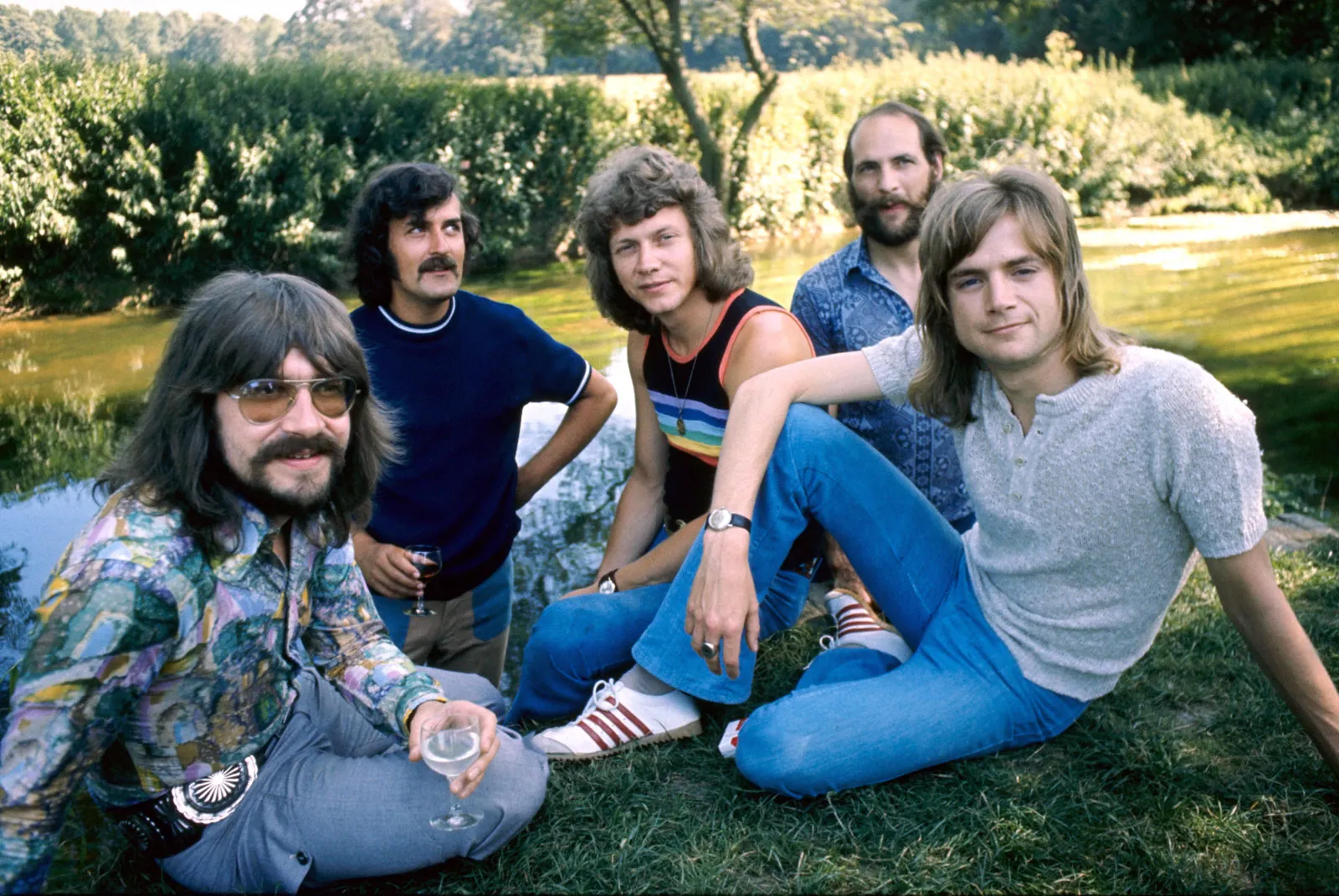The Moody Blues are a British rock band formed in Birmingham in 1964, known for their pioneering fusion of rock, orchestral arrangements, and progressive themes. The original lineup included Denny Laine (vocals, guitar), Mike Pinder (keyboards), Ray Thomas (flute, vocals), Graeme Edge (drums), and Clint Warwick (bass). However, the band reached its classic lineup with Justin Hayward (guitar, vocals) and John Lodge (bass, vocals) joining in 1966, replacing Laine and Warwick. Their blend of rock with classical music elements and philosophical lyrics helped to shape the progressive rock genre.
Overview of The Moody Blues
- Formation and Early Years: The Moody Blues formed in 1964 in Birmingham, England, initially playing R&B covers. Their first single, “Go Now,” became a No. 1 hit in the UK in 1965, but they struggled to find subsequent success with this early R&B style. As a result, the band underwent significant lineup changes and began experimenting with more complex musical arrangements.
- Transition to a New Sound: The turning point came in 1967 when the band, now featuring Hayward and Lodge, signed with Deram Records and released the groundbreaking album Days of Future Passed. This album was a conceptual piece that merged rock with orchestral music, using the London Festival Orchestra to create a symphonic rock sound. It featured the hit singles “Nights in White Satin” and “Tuesday Afternoon,” which helped establish their signature sound—characterized by lush arrangements, Mellotron-driven textures, and introspective lyrics.
- Rise to Prominence: The success of Days of Future Passed marked the beginning of a prolific period for the Moody Blues, during which they released a series of albums that defined their place in the rock canon. Albums like In Search of the Lost Chord (1968), On the Threshold of a Dream (1969), To Our Children’s Children’s Children (1969), and A Question of Balance (1970) solidified their status as a leading force in progressive rock. Their use of the Mellotron, along with other classical and psychedelic influences, set them apart from their contemporaries.
- Innovations and Themes: The Moody Blues were known for their innovative approach to album production. They were among the first bands to use the Mellotron extensively, which allowed them to replicate orchestral sounds in live settings. Their albums often explored philosophical themes, including spirituality, love, the human condition, and existential questions, which resonated deeply with the countercultural movements of the late 1960s and early 1970s.
- Continued Evolution and Later Years: After a brief hiatus in the mid-1970s, the Moody Blues returned with a more commercial sound in albums like Long Distance Voyager (1981) and The Other Side of Life (1986), which featured the hit single “Your Wildest Dreams.” They continued to adapt to changing musical landscapes while maintaining their core sound, successfully balancing progressive rock and pop sensibilities.
- Legacy and Recognition: The Moody Blues remained active into the 21st century, embarking on numerous tours and continuing to release new music. They were finally inducted into the Rock and Roll Hall of Fame in 2018, acknowledging their influence on rock music and their role in pioneering the art-rock and progressive rock genres.
Impact on Music and Culture
- Pioneers of Symphonic Rock: The Moody Blues were among the first bands to blend rock music with orchestral elements, helping to establish the “symphonic rock” subgenre. Their work paved the way for other progressive rock acts like Yes, Genesis, and King Crimson, who would further explore the fusion of rock and classical music.
- Popularizing Concept Albums: With Days of Future Passed, the Moody Blues were instrumental in popularizing the concept album format, where albums are unified by a single theme or story. This approach influenced a wide range of artists and became a hallmark of the progressive rock movement.
- Use of the Mellotron and Orchestration: The band’s innovative use of the Mellotron, a tape-based keyboard that could mimic the sounds of strings, flutes, and other instruments, became a defining feature of their sound and was later adopted by many other bands. Their lush orchestrations and ambitious arrangements expanded the possibilities of rock music.
- Cultural Influence and Legacy: The Moody Blues’ introspective and often spiritual lyrics connected with the countercultural movements of the 1960s and 1970s, resonating with audiences who were exploring new ways of thinking and being. Their music has remained a staple in the catalogs of classic rock and progressive rock, continually influencing new generations of musicians.
The Moody Blues Best Of The Moody Blues Playlist:
1
/
2
Nights In White Satin
The Moody Blues – Your Wildest Dreams
The Moody Blues – "Tuesday Afternoon" (Official Video)
Question
Ride My See-Saw
The Story In Your Eyes (2008 Remaster)
Melancholy Man
Go Now
The Moody Blues – I'm Just A Singer (In A Rock And Roll Band)
The Moody Blues – I Know You're Out There Somewhere
The Voice
Voices In The Sky
Isn't Life Strange
Legend Of A Mind
Lovely To See You
1
/
2
References
- Covach, John. What’s That Sound? An Introduction to Rock and Its History. W.W. Norton & Company, 2006.
- Romano, Will. Mountains Come Out of the Sky: The Illustrated History of Prog Rock. Backbeat Books, 2010.
- Swenson, John, ed. The Rolling Stone Jazz & Blues Album Guide. Random House, 1999.
- Rock and Roll Hall of Fame. “The Moody Blues.” Rock Hall, 2018.
- Mike Pinder and Ray Thomas, Days of Future Passed Liner Notes, 1967.


Leave a Reply